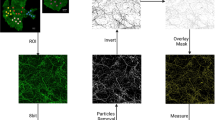Abstract
HNK-1 expression was studied by immunohistochemistry in serial sections of embryonic and fetal rat hearts from 11.5 to 16.5 embryonic days. Graphic reconstructions were made to obtain detailed 3D information on the localization of immunoreactive tissues. The antibody used appeared to stain most parts of the venous sinus and the sinuatrial transitional zone as well as the atrioventricular transitional zone, but the patterns varied through the different developmental stages. At 11.5 days, positive myocardium was found in the right atrium and on top of the ventricular septal primordium. At 13.5 days, the left venous valve and the posterior atrial wall containing the orifice of the pulmonary vein were immunoreactive, and so were the right venous valve, the septum spurium and the superior, right-lateral and inferior parts of the atrioventricular canal. From the latter, immunoreactivity continued onto the crest of the ventricular septum. At 15.5 days, HNK-1 positivity in the two venous valves had become continuous, whereas the right-lateral part of the atrioventricular canal had lost its positivity, thus making the positive areas in the superior and inferior parts of this canal discontinuous. From the venous valves immunoreaction continued into the venous sinus septum but this area remained discontinuous with the inferior part of the atrioventricular canal. It is concluded that the entirety of venous sinus and sinuatrial transitional zone expresses the HNK-1 antigen and that the orifice of the pulmonary vein belongs to this complex, rather than to the embryonic atrium proper, which is HNK-1 negative. Extrapolation of these data to the adult human atrium leads to the conclusion hat most ’’atrial septal structures’’ are of sinuatrial origin, leaving the flap valve of the oval fossa (atrial septum primum) as the only really atrial structure. It is suggested that the atrioventricular node is derived from the inferior portion of the atrioventricular canal, and that two expansions of sinuatrial tissue form the substrate for anterior and posterior atrionodal inputs which in the literature have been described as internodal tracts.
Similar content being viewed by others
Author information
Authors and Affiliations
Additional information
Accepted: 17 June 1999
Rights and permissions
About this article
Cite this article
Wenink, A., Symersky, P., Ikeda, T. et al. HNK-1 expression patterns in the embryonic rat heart distinguish between sinuatrial tissues and atrial myocardium. Anat Embryol 201, 39–50 (2000). https://doi.org/10.1007/PL00008227
Issue Date:
DOI: https://doi.org/10.1007/PL00008227




